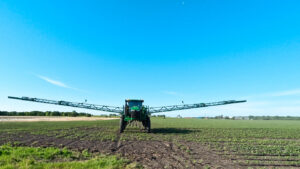The global grain economy is staggering in size. In the US alone, half a million farms produce about $60 billion in revenue. Surprisingly, the most significant source of pain for the Goliath that is the grain industry is microscopic mold. If grain isn’t dried correctly before being stored or transported, mold soon takes hold and can contaminate an entire shipment rapidly if the moisture and temperature conditions are just right.
There are a large number of precision ag startups that are innovating for pre-harvest solutions, including companies offering in-field sensors and drones fitted with hyper-spectral imaging cameras to identify pest or disease before the pressure becomes too great. Farm management software startups raised nearly $1 billion, last year according to AgFunder’s 2018 AgriFood Tech Investing Report, including startups creating solutions based on software, sensing, and IoT technology.
When it comes to post-harvest storage, preservation and moisture management, however, the innovation landscape is a bit stark. Although the post-harvest grain space is a massive opportunity, for Naeem Zafar, president and CEO of grain IoT technology company TeleSense, it feels like he’s found his niche.
“There are maybe only two or three companies other than us trying to provide post-harvest solutions. We found our niche, but it’s a huge niche. Pre-harvest, there are about 10 to 20 companies providing solutions,” he told AgFunderNews.
TeleSense’s proprietary sensor collects data about the condition of grains in storage to detect non-optimal storage conditions and reduce spoilage. TeleSense has designed a sensor that can be thrown into a pile of grain or any storage facility and transmits data up-to four times a day about the temperature and humidity of a storage facility. The startup then gives clients real-time information about their grain such as when there are hot spots, which can rapidly develop into fires. Machine learning algorithms will also give them recommendations about when to fumigate, how long to store, and also what the quality will be like in the future to help them decide when to sell.
The startup, which counts major international shipping outfit Maersk Growth among its investors, recently announced its acquisition of Danish wireless sensor technology company Webstech. This gives TeleSense the largest remote-sensed dataset for grain storage in the world by its account, allowing it to offer customers sensor technologies built to serve grain storage needs around the world. The company closed a $6.5 million Series A last year.
“We were looking at how to expand our footprint in Europe where there are a lot of complicated regulations and every country is different. It’s not like states in the US; you need to find a local entity who knows the regulations and nuances,” Zafar explained. “Webstech had been doing business for a few years, and they have a lot of customers. We think you have to play offensively and defensively. If some future competitor buys them, then we have to fight them both. Why not buy them ourselves and make them part of our army?”
Webstech will now operate as TeleSense Europe from an office located in Denmark. The current plan is for the new acquisition to continue serving its current clientele while hunting for a few bigger fish in grain-rich regions.
“Eastern Europe is the prize. They have lots of grain but lack infrastructure. Our product is designed so that you don’t need all of the infrastructure. You literally dig a hole in the mound and toss in a few of our spheres that have a cellular connected gateway. I call it a five-minute install.”
According to Zafar, less than 30% of the 475,000-grain storage locations worldwide have some instrumentation deployed to gather data, mostly measuring temperature with only a few measuring humidity. And even those examples required manual operation and data collection. Another major challenge in some regions is a lack of cellular connectivity, making it challenging to send valuable data to the cloud for analysis.
TeleSense and its new acquisition will target the grain elevators and “off-farm” storage operators first before marketing their technology to on-farm operations that represent 55% of storage globally. Targeting elevators and larger storage companies will also help it aggregate more data that it can use to fine-tune operations on a farmer-by-farmer basis.
It’s unsurprising that Zafar wants to aim high before offering his technology to small-scale farmers. Five companies exercise control over the world’s grain trade: Archer Daniels Midland, Bunge, Cargill, Glencore International, and Louis Dreyfus. These titans not only have the global reach to help a startup scale more rapidly than it could on its own, but they also have some of the deepest pockets around.
As far as acquisitions go, this is unlikely to be the last for TeleSense. For now, the company is focusing on making Webstech a cohesive part of the company, but Zafar sees too many prime opportunities for additional acquisitions down the road, particularly in complicated regions like the EU and South America where producers face even greater challenges with humidity and where regulations are also cumbersome.
“This strategy makes sense. There are a lot of little companies that have little pieces of technology around the world. What they lack are capital and momentum. Our board is pleased that this could be a way to expand the business and our footprint. My goal, for now, is to demonstrate that this acquisition is working well and that we have mastered the transition. When you bring a new organ into the company, you have to make sure it works well.”




